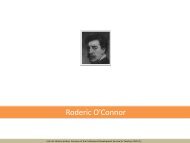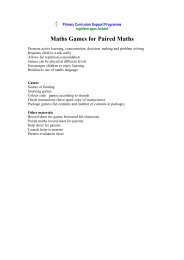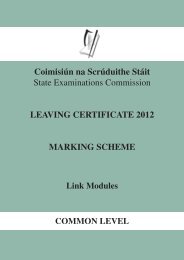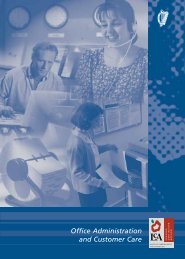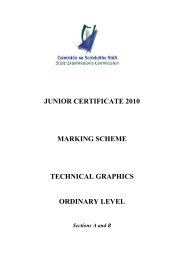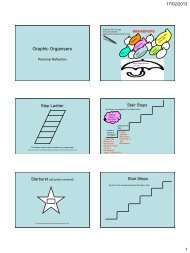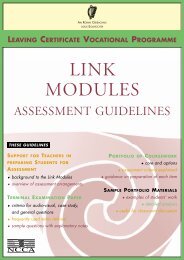82• DiGregorio, P. & Sobel-Lojeski, K. (2010). The effect of <strong>in</strong>teractivewhiteboards on student performance and learn<strong>in</strong>g: a literature review.Journal of Educational Technology Systems. Vol. 38(3), 255-312.• Dexter, S. (2008). Leadership for IT <strong>in</strong> schools. In: J. Voogt & G. Knezek(Eds). International Handbook of Information Technology (pp. 543-554).New York: Spr<strong>in</strong>ger.• Droop, M., Segers, E. and Blijleven, P. (2011). Wat weten we over…webquests <strong>in</strong> het primair onderwijs? Zoetermeer: Kenn<strong>is</strong>netOnderzoeksreeks, No. 33. *• Eck, E. van, Heemskerk, I. & Meijer, J. (2009). RapportageSchoolontwikkel<strong>in</strong>gsonderzoek, uitgevoerd <strong>in</strong> het kader van LMME2.Amsterdam: Kohnstamm Instituut. *• Eck, E. van, Heemskerk, I. & Meijer, J. (2010). Opbrengsten van Leren metmeer effect. Zoetermeer: Kenn<strong>is</strong>net Onderzoeksreeks, No. 23. *• Erstad, O. (2009). Address<strong>in</strong>g the complexity of impact. In: F.Scheurmann & F. Pedro (Eds). Assess<strong>in</strong>g the effects of ICT <strong>in</strong> education(pp. 21-40). Luxembourg: Jo<strong>in</strong>t Research Centre – European Comm<strong>is</strong>sion.• Ertmer, P.A. (2005). Teacher pedagogical beliefs: The f<strong>in</strong>al frontier <strong>in</strong>our quest for technology <strong>in</strong>tegration? Educational Technology Researchand Development, 53 (4), 25-39.• Ertmer, P.A. & Ottenbreit-Leftwich, A.T. (2009). Teacher TechnologyChange: How Knowledge, Beliefs, and Culture Intersect. Available athttp://onderzoek.kenn<strong>is</strong>net.nl/onderzoeken-totaal/techchange. *• Etuce (2009). Enhanc<strong>in</strong>g pedagogical use of ICT <strong>in</strong> education. Brussels:European eLearn<strong>in</strong>g Forum for Education.• Eurydice (2011). Key data on learn<strong>in</strong>g and <strong>in</strong>novation through ICT atschool <strong>in</strong> Europe 2011. Brussels: Eurydice. Available athttp://eacea.ec.europa.eu/education/eurydice/.• European Comm<strong>is</strong>sion (2010). Learn<strong>in</strong>g, <strong>in</strong>novation and ICT. Lessonslearned by the ICT cluster Education & Tra<strong>in</strong><strong>in</strong>g 2010 programme.Available at www.kslll.net.• European Communities (2007). Key competences for lifelong learn<strong>in</strong>g.Luxembourg: Office for Official Publications of the EuropeanCommunities. Available at http://ec.europa.eu/dgs/education_culture/publ/pdf/ll-learn<strong>in</strong>g/keycomp_en.pdf.
10 - bibliography• F<strong>is</strong>ser, P.G.H. & Gerved<strong>in</strong>k Nijhu<strong>is</strong>, G.J. (2007). E<strong>in</strong>drapportage digitaleschoolborden. Enschede: Universiteit E<strong>in</strong>dhoven. Also publ<strong>is</strong>hed <strong>in</strong> theKenn<strong>is</strong>net Onderzoeksreeks as “Digitale Schoolborden <strong>in</strong> het po”, 2008,No. 6. *• Fullan, M. (2011). Choos<strong>in</strong>g the wrong drivers for whole systemreform. Centre for Strategic Education Sem<strong>in</strong>ar Series Paper No. 204.Melbourne: Centre for Strategic Education.• Gennip, H. van & Rens, C. van (2008). Didactiek en Leiderschap <strong>in</strong> Balans.Nijmegen: ITS. *• Gennip, H. van, Rens, C. van & Mooij, T. (2009). Ander onderwijs metdigitaal portfolio? Nijmegen: ITS. *• Gennip, H. van & Rens, C. van (2011a). Didactiek <strong>in</strong> Balans 2011. Specialethema’s en verantwoord<strong>in</strong>g bas<strong>is</strong>onderwijs. Nijmegen: ITS. *• Gennip, H. van & Rens, C. van (2011b). Didactiek <strong>in</strong> Balans 2011.Voortgezet onderwijs. Nijmegen: ITS. *• G<strong>in</strong>kel, M. van (2009). Het effect van multimediagebruik op het leren vanvaardigheden <strong>in</strong> het Praktijkonderwijs. Gron<strong>in</strong>gen: research project,Gron<strong>in</strong>gen University. *• Hagemans, M.G. (2008). Het aanbieden en de tim<strong>in</strong>g vandome<strong>in</strong><strong>in</strong>formatie tijdens onderzoekend leren met computersimulaties.Enschede: Master’s Thes<strong>is</strong>, Twente University. *• Hattie. J.A.C. (2009). V<strong>is</strong>ible learn<strong>in</strong>g: a synthes<strong>is</strong> of meta-analysesrelat<strong>in</strong>g to achievement. New York: Routledge.• Heemskerk, I., Eck, E. van & Meijer, J. (2010). Digitaal schoolbord enelektron<strong>is</strong>che leeromgev<strong>in</strong>g <strong>in</strong> het w<strong>is</strong>kundeonderwijs: gebruik enpercepties van docenten en leerl<strong>in</strong>gen. Amsterdam: KohnstammInstituut. *• Heemskerk, I., Meijer, J., Eck, E. van, Volman, M., Karssen, M., <strong>in</strong>cooperation with Kuiper, E. (2011) EXPO II. Experimenteren met ict <strong>in</strong>het PO tweede tranche: onderzoeksrapportage. Amsterdam: KohnstammInstituut van de Universiteit van Amsterdam. *• Hoogeveen, J. & Scheeren, J. (2010). ICT en de <strong>in</strong>vloed op deonderwijsarbeidsmarkt. The Hague: SBO. Available athttp://www.onderwijsarbeidsmarkt.nl/publicaties/2010/ict-leidt-totandere-personele-samenstell<strong>in</strong>g-<strong>in</strong>-school/.• Hovius, M., Kessel, N. van & L<strong>in</strong>den, M. van der (2010). Engels metdigibord of boek? Nijmegen: ITS. *83
- Page 1:
Four in Balance Monitor 2011ICT in
- Page 4 and 5:
ContentsMain topics 61 What is Four
- Page 6 and 7:
Main topicsThe Four in Balance Moni
- Page 8:
learning materials. That is 10% mor
- Page 11 and 12:
1 - what is four in balance?In many
- Page 13 and 14:
1 - what is four in balance?1.3 The
- Page 15 and 16:
2 - Benefits of using ICT2Benefits
- Page 17 and 18:
2 - Benefits of using ICTIn this ch
- Page 19 and 20:
2 - Benefits of using ICTThe rest o
- Page 21 and 22:
2 - Benefits of using ICTA good exa
- Page 23:
2 - Benefits of using ICTOne good e
- Page 26 and 27:
Pupils learn skills and acquire kno
- Page 28 and 29:
The debate concerning the importanc
- Page 30 and 31:
Competence-based professional envir
- Page 32 and 33: • ICT can be conducive to knowled
- Page 34 and 35: NumberThree quarters of teachers us
- Page 36 and 37: The number of lesson hours in which
- Page 38 and 39: 3.2 Teachers at homeVirtually all t
- Page 40 and 41: Actual useHomework assignments that
- Page 42 and 43: Learning at school and at homeWe se
- Page 44 and 45: 4VisionThe way in which teachers us
- Page 46 and 47: Pedagogical vision of ICT in PRIM a
- Page 48 and 49: 4.4 Summary• Knowledge transfer i
- Page 51 and 52: 5 - ExpertiseThe percentage of teac
- Page 53 and 54: 6 - Digital learning materials6Digi
- Page 55 and 56: 6 - Digital learning materials6.2 P
- Page 57 and 58: 6 - Digital learning materialsTeach
- Page 59 and 60: 7 - ICT infrastructure7.1 Computers
- Page 61 and 62: 7 - ICT infrastructurelaptops with
- Page 64 and 65: 7.3 ConnectivityWe make a distincti
- Page 66 and 67: 8Collaboration and leadershipSchool
- Page 68 and 69: SupportWhere can teachers turn if t
- Page 70 and 71: Centralized visionSchools do not al
- Page 72 and 73: Leadership focusing on material and
- Page 74 and 75: 9From ICT use to moreeffective teac
- Page 76 and 77: for example, or learn skills in a s
- Page 78 and 79: doing schoolwork at their home comp
- Page 80 and 81: 1080Bibliography• Anderson, R. (2
- Page 84 and 85: 84• Ict op School (2004). Vier in
- Page 86 and 87: 86• Marzano, R. & Haystead, M. (2
- Page 88 and 89: 88• Somekh, B., Haldane, M., Jone
- Page 90 and 91: • Wopereis, I. & Sloep, P. (2009)
- Page 92: Kennisnet FoundationAddressPaletsin



